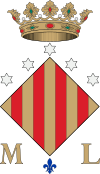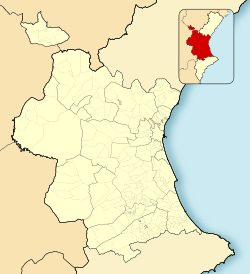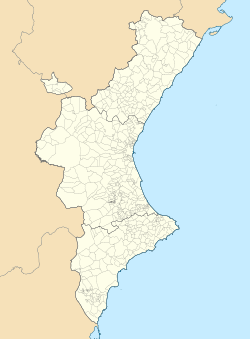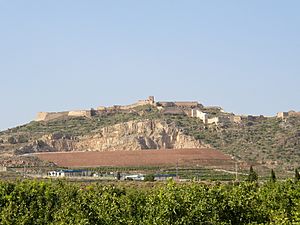Sagunto facts for kids
Quick facts for kids
Sagunto
|
|||
|---|---|---|---|
 |
|||
|
|||
| Country | |||
| Autonomous community | |||
| Province | Valencia | ||
| Comarca | Camp de Morvedre | ||
| Founded | Before 219 BC | ||
| Government | |||
| • Type | Mayor-council government | ||
| • Body | Ayuntamiento de Sagunto | ||
| Area | |||
| • Total | 132 km2 (51 sq mi) | ||
| Elevation | 49 m (161 ft) | ||
| Population
(2023)
|
|||
| • Total | 70,486 | ||
| • Density | 532/km2 (1,380/sq mi) | ||
| Demonym(s) | Saguntino, saguntina Saguntí, saguntina Morvedrí, morvendrina |
||
| Official languages | Spanish Valencian |
||
Sagunto is a city in Spain. It is located in the province of Valencia, in the Valencian Community. Sagunto is about 30 kilometers (18 miles) north of the city of Valencia. It is also very close to the Mediterranean Sea.
Sagunto is famous for its ancient ruins from the Iberian and Roman times. The city was once called Saguntum. A major event in its history was the siege of Saguntum in 219 BC. This battle started the Second Punic War between the Carthaginians and the Romans.
The city has three main parts: Ciutat Vella (Old City), Grau Vell, and Puerto de Sagunto. More than half of the people live in Puerto de Sagunto, which is on the coast.
Contents
A Look at Sagunto's Past
Some historians believe the first people in Sagunto were families from Armenia. Others think Greeks from the island of Zakynthos might have founded the city around 500 BC.
Early Iberian Settlement
Around 500 BC, the Iberians built a walled town on a hill. You can still see parts of their old walls today. The city was known as Arse back then. It traded with other cities around the Mediterranean Sea, like Carthage. The city even made its own coins.
Roman Times and the Punic Wars
By 219 BC, Saguntum was a busy and rich city. It was friends with Rome and its local allies. This made Hannibal, a famous general from Carthage, attack the city. His siege of Saguntum lasted eight months. Even though the people fought bravely, Hannibal captured the city. This event began the Second Punic War, a very important war in ancient history.
Seven years later, the Romans took the city back. In 214 BC, Saguntum became a Roman city and grew strong again. The Romans built a large circus and a theater that could hold 8,000 people. Records show the city also had an amphitheater and about 50,000 residents. This good time lasted for most of the Roman Empire.
From Visigoths to Muslims
Later, under the Visigoth kings, Saguntum got its Catholic patron saint, Bishop Sacerdos. He passed away around AD 560.
In the early 700s, Muslim Arabs conquered Spain. Sagunto became part of the Caliphate of Cordoba. The city had a golden age with baths, palaces, mosques, and schools. It was known as Morvedre (meaning "ancient walls"). However, as the city of Valencia grew, Sagunto became less important.
In 1098, the famous warrior El Cid captured the city, but the Muslims soon took it back. Sagunto was under Muslim rule for over 500 years. Then, in 1238, James I of Aragon conquered it.
Modern History and Industry
During the Peninsular War in 1811, French forces attacked the castle. A Spanish attempt to stop them failed in the Battle of Saguntum. The castle was badly damaged. To repair the old walls, much of the Roman theater was taken apart.
Sagunto was damaged by wars, but it still has many old buildings from the Valencian Gothic style. In the late 1800s, a steel-making industry started in Sagunto. This helped the modern city grow. The last steel oven closed in 1984. It has since been fixed up and is now a place for tourists to visit.
Jewish History in Sagunto
Sagunto was once home to a Jewish community. There's a legend that a tombstone was found there. It said "Adoniram, treasurer of King Solomon, who came to collect the tax tribute and died." Jews lived in the city during Muslim rule. After a terrible event in 1391, the Jewish community in Sagunto was the only one left in Valencia. In 1492, when Jews were expelled from Spain, about 500 Jews left Sagunto for North Africa and other parts of Europe.
The Judería (Old Jewish Quarter) is one of the best-preserved in Spain. You can enter it through an arch called "Portal de la juheria."
Places to See in Sagunto
Sagunto has many interesting historical sites to explore:
- The Sagunto Castle sits on top of the hill. It has many old walls from Roman and Moorish times.
- A Roman theater is on the north side of the castle hill. It was partly fixed up in the late 1900s. It was the first official National Monument in Spain, declared in 1896.
- The Església de Santa Maria (St Mary's Church) is a Gothic church in the main square.
- The Palau Municipal (City Palace) is the town hall. It's a beautiful building from the 1700s.
- The early Gothic Església del Salvador (Church of Our Savior).
- The narrow streets of the Juderia (Old Jewish Quarter) are on the hillside leading up to the castle.
- The Santa Ana convent from the 1200s is next to the Plaça de Pi.
- The Sagunto History Museum is in a building from the 1300s and 1400s in the Jewish quarter. It has a large collection of items from the Iberian and Roman periods.
Sports in Sagunto
CD Acero is the city's football (soccer) team. Their stadium is called El Fornás, and it's located in Puerto de Sagunto.
Images for kids
See also
 In Spanish: Sagunto para niños
In Spanish: Sagunto para niños











